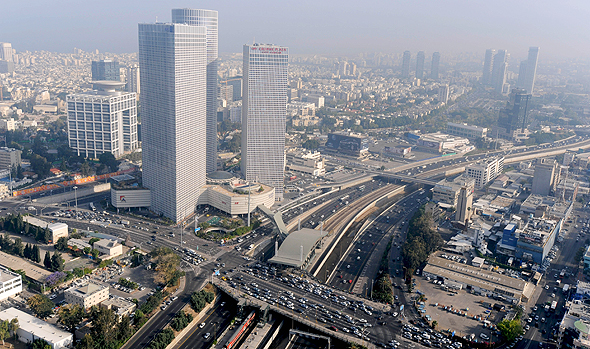Israel’s Income Polarization Just Keeps Growing
A recent report by Israel’s Central Bureau of Statistics shows that while on the surface inequality is getting better, the situation of Israel’s lowest earners keeps getting worse
18:2628.11.19
On Tuesday, Israel’s Central Bureau of Statistics published its household expenditure survey for 2018, and Israel’s policymakers should find the results illuminating—and concerning. In short, Israel’s income gap is becoming deeper and wider.
 Tel Aviv. Photo: Bloomberg
Tel Aviv. Photo: Bloomberg
One measurement cited in the report is the Gini coefficient, which is a comparison of cumulative proportions of the population against cumulative proportions of the income they receive. It ranges between 0, perfect income equality, and 1, perfect inequality. Israel’s Gini coefficient for 2018 was 35.5%, according to the CBS, a 1.1% increase from 2017 but still one of the lowest Gini coefficient levels seen in Israel after a sharp drop experienced over the last two decades. While on an international scale Israel still makes the top 10 in terms of inequality among OECD countries, it is no longer in the top five like it was until five years ago.
 Tel Aviv. Photo: Bloomberg
Tel Aviv. Photo: Bloomberg
Good news? Not really. Israel’s most acute problem is the polarization between its top earners and its lowest earners, measured based on the P90/P10 ratio. The P90/P10 is the ratio of the upper bound value of the ninth decile, meaning the 10% of people with the highest income, to that of the first decile. In Israel in 2018, that ratio was 8.4: the average income for the ninth decile was NIS 40,254 (approximately $11,600) per month, while the average monthly income for the first decile was NIS 4,786 (approximately $1,380). It is an extremely high ratio for an OECD country, and what’s worse, it represents a 14% increase from 2017, when it was 7.4.
Those who think that the disparity grew due to an increase in the percentage of income the rich contribute to the national pot are mistaken. Over the past decade, the contribution of the ninth decile dropped from 24.5% to 23%. The same is true when one looks at the bottom 20%, which saw a drop from 40% to 38%. When one looks at expenditure, the ninth decile only spends 2.4 times as much as the first decile.
To further prove that it is not your run-of-the-mill inequality but deep polarization that’s plaguing the Israeli economy, one should take a look at the Palma ratio, an index created a decade ago that has been picking up interest lately. The Palma ratio is the share of all income received by the ninth decile divided by the share of all income received by the 40% of people with the lowest disposable income. CBS data for the past two decades shows Israel’s Palma ratio dropped from 1.4 to 1.14, meaning that in 2009, the ninth decile had 40% more disposable income than the four lowest deciles, but now it only has 14% more.
When considering both the Gini coefficient and the Palma ratio, the picture is clear: Israel’s inequality is getting better, but there is a real problem with the income of Israel’s lowest deciles.
Related stories:
- OECD Cuts Israel’s Economic Growth Prediction for 2020 to Under 3%
- Wages Predict Career Advancement Expectations, New Data Shows
- The Israeli Economy's Greatest Growth Generator Is Also its Biggest Enemy
Israel’s bottom two deciles, the lowest 20% of earners, are made largely of two population groups, Arabs with Israeli citizenship and ultra-Orthodox Jews (Haredi). Both groups are characterized by large nuclear families, low participation in the job market, and low wages as a direct result of low levels of education. According to CBS data, the average household of the bottom two deciles has 4.1 people, compared to 2.6 people in the top two deciles, or the top 20% of earners. The average number of wage earners for the bottom two deciles was 0.9, while for the top two deciles it was 1.7. Furthermore, for the bottom two deciles, 34.3% of income was state financial aid—every third shekel was not the result of work or investments but given by the state. Another relevant piece of data is that for the ninth decile, the average monthly income of NIS $1,380 covers only 53% of the monthly expenditure of NIS 8,998 (approximately $2,600). For the second decile, the average income of NIS 7,527 (approximately $2,170) only covers 77% of the monthly expenditure of NIS 9,777 (approximately $2,820).
Israel’s policymakers should come away from this report with one conclusion: Israel’s macro social-economic policy should focus much more on its two bottom deciles. That cannot be accomplished by simply increasing the already substantial government aid, which would only cement the current situation. Instead, Israel must invest in education, professional training, and infrastructure. And this action is needed immediately, as the percentage of those groups out of Israel’s population is on the rise. Without action, polarization will only increase. Israel will not be able to sustain long-term economic growth if large parts of the population will not contribute to the economy.



